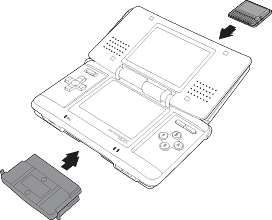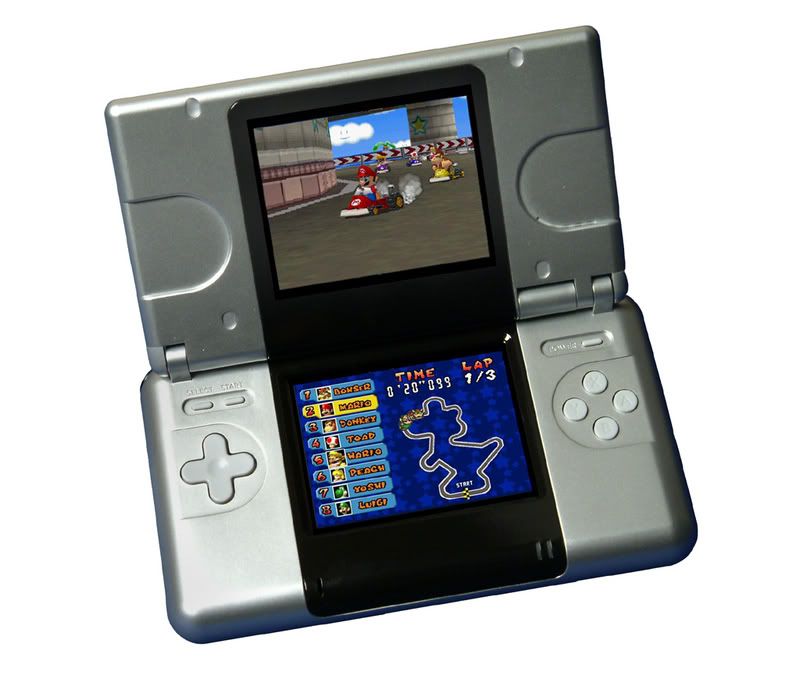I wrote this review on the DS a while back, in 2007. I still don't have one of my own - the one I tested belonged to my boyfriend at the time, Kevin.
I'm hoping to buy myself one this year, which is why I'm reposting the review (that, and it's one of my best). My games systems are currently limited to a Gamecube, PS2 and GBA, which is why I've been out of the, haha, game for a few years now. I miss the excitement of being able to go into a gameshop, and come out with new and exciting possibilities. I really doubt, at this point, that I'll find any game I haven't heard of before in the second hand PS2 section.
I'm hoping to buy myself one this year, which is why I'm reposting the review (that, and it's one of my best). My games systems are currently limited to a Gamecube, PS2 and GBA, which is why I've been out of the, haha, game for a few years now. I miss the excitement of being able to go into a gameshop, and come out with new and exciting possibilities. I really doubt, at this point, that I'll find any game I haven't heard of before in the second hand PS2 section.
I'd be something of a retro gamer by choice, but it's about money and effort too. I'm not a huge action or FPS fan, like a lot of gamers online seem to be, and I really don't fancy putting in the energy to keep up.
Anyway - one of the few times I managed to review something while it was still new and exciting;
Backwards Compatibility
Nintendo's most recent handheld system, the DS, is, happily, backwards compatible with Game Boy Advance games, although not with Game Boy or Game Boy Colour cartridges. I'm afraid I've yet to test how well the games transfer, but I will update this review once I have.

Backwards compatability - the DS game discs fit in the smaller slot, while GBA cartridges fit in the larger one. A plastic cover allows the system to keep it's streamlined shape, with or without a cartridge inserted.
Dual Display and Touch Screen
The system features two display screens, the lower one of which has a touch-sensitive overlay. This is designed to accept input from a stylus, or from the player's fingers, and is put to good use in many games – for instance, in Final Fantasy III, you can open the menu simply by touching the on screen button, and your lead character can move by following your touch across the screen. It's also used to guide a scalpel in games like Trauma Center: Under the Knife, or to collect fingerprints in the Phoenix Wright: Ace Attorney games. There is a very neat little slot for the stylus on the DS itself.
The separate visual screens are made use of in various ways – for instance, when shopping in Final Fantasy III, the lower screen will display the goods available while the upper screen shows which of your characters can equip whichever item is highlighted. In other games, one display screen will show a world map, while the other will show a more detailed overlay of the area your character currently inhabits. Text will sometimes appear in one window, while commands appear on the touch sensitive screen, making the system slightly more versatile. The screen is backlit, one of my favourite features since the GBA, as it completely nullifies the need to angle the system just right in order to be able to see what you're doing.
The touch screen can be marked with fingerprints, but is easily cleaned, in the same way as a pair of glasses, with a silk cloth, which is often included in any carrying cases you may buy.
Portability and Charging
Although there are cases, designed to be worn around the neck, to carry the DS, the system is actually too large to be comfortably carried this way. Although not really heavy, it's 5.85 x 3.33 x 1.13 inches – about the same size as an old style, original Game Boy. Although, once unfolded, it's nothing like as unwieldy as the aforementioned system, when you're carrying it in a case, that won't make any difference. The DS Lite is 5.24 × 2.9 × 0.85 inches, which, although a slight improvement, still won't make it easier to carry. It will fit in a large coat pocket, however.
The batteries have a relatively long life span, and, like the GBA, if you make a habit of keeping the system plugged into a charger while playing, it won't die on you. The charger itself has a slight overhang, so you need to be keep it at the edge of any plug sockets so it doesn't get in the way of anything else. This is a pain, but the prongs of the plug fold back into itself when it's not in use, which prevents damage. It's a lot smaller than the GBA charger. Car chargers are available.
Microphone and Other Features
The system uses stereo speakers to create virtual surround sound. It also includes a microphone, which is used in several games, although its effectiveness is debatable. It's usually theorized that the responsiveness or lack thereof is determined by the game, not the system itself.
Although I've yet to experiment with them, other features include download play and Wi-Fi connectivity. With certain games, you are able to play multiplayer games with only one game card.
Graphics
The graphics most resemble those of the GameCube, and the amount of detail is improved from the GBA – think Playstation towards the end of its lifespan. The colours and shading are fantastic, and the system can support some very good quality FMVs, although in the games I've seen so far, these are only in short bursts.
Gameplay
The DS handles like a cross between a GameCube and a GBA. On the left hand side of the lower screen is a four-way directional pad, which gamers will recognize from pretty much every other system. On the right is the Start, Select, A, B, X and Y buttons common to Nintendo systems. There are also L and R buttons on the upper edge of the system.
The system is able to store your preferences to a certain extent – for instance, it can remember your name and other details, and you can choose whether you want it to load the game inserted immediately when switched on, or whether you prefer it to go to a menu screen first. It also includes an internal clock, which is used as an element of many games, although since it has no verification other than itself, it can be abused. For instance, in Final Fantasy III, the waiting period of an hour between mail can be bypassed simply by resetting the clock.
Games and Game Discs
There are several decent games for the Nintendo DS, including it's distinction as the one system on which Final Fantasy III is available in Europe and North America. Although the DS seems to suffer from a large number of film and TV spin-off games, there are a few RPG's, such as the aforementioned Final Fantasy, and some more niche games, such as the Sims, Harvest Moon, and re-releases of the first two Phoenix Wright: Ace Attorney games. The DS is region free.
The game cases have improved significantly over the GBA's cardboard boxes. The new cases resemble Playstation sized PS2 boxes, in molded plastic, that actually hold the games in place, and include space for peripherals, such as styluses. While I found myself storing GBA cartridges separately from the boxes, since they were unwieldy and annoying, DS cases actually fit very neatly on shelves, look much nicer, and are easier to use. Smaller cases, designed to protect the game cards alone during transport are available, but I'm paranoid that I'll lose them. The game cards are 33.0 × 35.0 × 3.8 mm – in other words, about the same size as a small piece of thick cardboard. Your progress is, once again, stored on the game cards, not the system, and the amount of memory doesn't seem to have improved significantly.
Summary
In summary, while the DS features many new innovations, such as the microphone, and touch screen, it also isn't too far removed from the GBA. This isn't a bad thing. Although it has taken steps far ahead of the older systems, it still retains the best elements of them.
Its backwards compatiblity with the GBA and the fact that it's region-free, means that there is a wide variety of games available.
All in all, I'd say that for anyone who wants to play games on the go, it's pretty good value. Of course, it really depends on your taste in games.

No comments:
Post a Comment